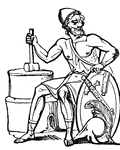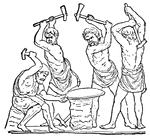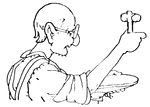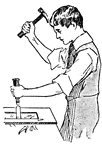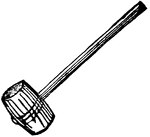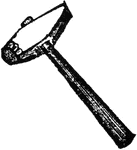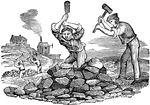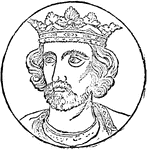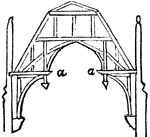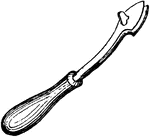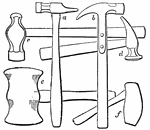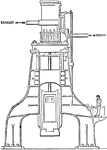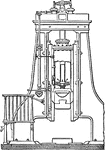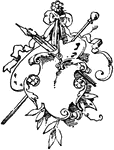
Carillon without Clavier
A series of small bars of steel or bronze, so placed that they can be struck by a small hammer, and…
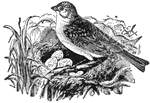
Yellowhammer
The yellow hammer, or yellow bunting; a bird widely distributed over Europe and North America

Hammerhead Shark
"Having a body like other sharks, but with a double snout like a double-headed hammer, and having an…

Apollo Room
"The Apollo Room. The room used for public meetings is in the rear building of the old Raleigh tavern…

Perna isognomum
"The Perna isognomum has a somewhat similar form to the Hammer Oyster; it lives in deep water,…
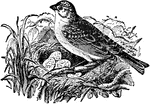
Yellowhammer
"The Yellow Hammer, or Yellow Bunting, is a bird widely distributed over North America and Europe. It…
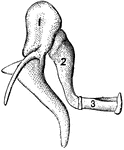
Bones of the Ear
"1, malleus, or hammer; 2, incus, or anvil; 3, stapes, or stirrup." — Blaisedell, 1904
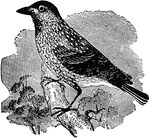
Nutcracker
"The Nut Cracker is a bird of Southern Europe. They feed on the seeds of pine and beech, and on nuts,…
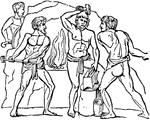
Malleus
"A hammer, a mallet. In the hands of the farmer the mallet of wood served to break down the clods and…

Characters
Characters of the Native Americans. The eight figures in the upper row, with hats on, and with muskets…

Bones of the Ear
"Across the middle ear a chain of three small bones stretches from the tympanic membrane to the inner…
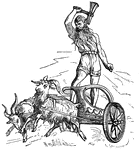
Thor
"Thor, the thunderer, Odin's eldest son, is the strongest of gods and men, and possesses three very…

Revolver
A firearm resembling a pistol, but differing from it in having a breech-loading cylinder so arranged…
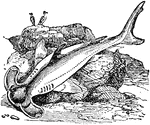
Hammerhead Shark
The eight species of hammerhead range from 2-6m long, and all species have projections on both sides…
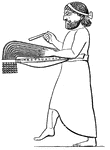
Ancient Percussion
There are several instances of some sort of ancient instrument, consisting of metallic plates or rods,…

English House Clock
"A front view of a common English house clock with the face taken off, showing the repeating or rack…

Quarter Clock
"The front view of a large quarter clock of Sir E. Beckett's design, with all the wheels on the great…

Lift Hammer
The lift hammer is a large hammer used in forges. The hammer is tilted up and then allowed to drop.

Alligator Squeezer
"Formerly the balls were squeezed by an "alligator" or "crocodile" squeezer, and were then "shingled"…

Wheel Rotation
"Rotation of a Wheel. The same force which throws the wire away from the mercury, will cause the rotation…

Triggerfish
A brightly colored fish. It is called the trigger fish because one large and sharp first ray of the…
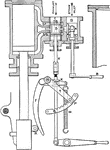
Valve gear of a steam hammer
"The valve gear for operating the steam hammer is shown separately, the cylinder and valve chest being…
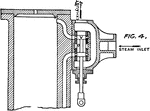
Vertical Section of a Double-Hammer Column
"A vertical section through the valve casing of a double-column hammer, used for heavy forge work."—Finley,…

Transverse Section of a Double-Column Hammer
"A transverse section through the valve casing of a double-column hammer, used for heavy forge work."—Finley,…
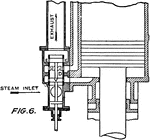
Valve Casing of a Double-column Hammer
"A section through the valve casing of a double-column hammer, fitted with a valve v provided with three…

Electric Bell
"An electric bell consists mainly of an electromagnet, E, and a vibrating armature that carries a hammer,…
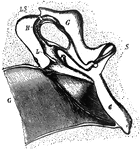
Middle Ear
The middle ear and its bones, considerably magnified. Labels: G, the inner end of the external auditory…

Neolithic Implements Stone and Horn Ax and Hammer
Stone and horn ax and hammer. A Neolithic age implement. Not drawn to scale.

Neolithic Implements Stone Mallets
Stone mallets and the North American Indian method of mounting. A Neolithic age implement. Not drawn…

Neolithic Implements Axe-hammers
Axe-hammers of polished stone. A Neolithic age implement. Not drawn to scale.
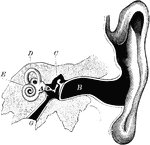
Ear
The human ear. Labels: A, vestibule or antechamber; B, auditory canal; C, the hammer, anvil, and the…

Malleus
The hammer-bone or malleus, seen from the front. 1, the head; 2, neck; 3, short process; 4, long process.
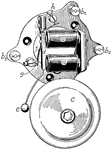
Electric Bell
An illustration of an electric bell. "The magnetizing coils are a a, and they are connected with their…
